p.89
p.95
p.99
p.103
p.107
p.111
p.115
p.119
p.123
Utilization from Okara to Replace Wheat Flour in Ice-Cream Cone
Abstract:
Research objectives were to study the formula, process and the ratio of Okara (Dry basis) to reduce the amount of wheat flour to produce the ice-cream cone. Gluten is a protein composite found in wheat (Triticum spp.) and related grains, including barley and rye which causes health problems in sufferers of celiac disease and some cases of wheat allergy. The Okara was prepared by dried at 70 degree Celsius, 10 hours after that grind and screen size unless 60 mesh. The experimental design was CRD at 3 levels (Okara:wheat flour) such as 30:70, 35:65 and 40:60. Use 9 Points Hedonic Scale test was performed for each treatment. Thirty panelists were most acceptable at 35:65 the result found the characteristic for odor was 6.80+ 1.03, taste was 7.23+ 0.97, texture was 7.23+ 0.72, and overall acceptance was 7.30+ 0.70 there were significant differences (p<0.05) which was well accepted with score 6-7 (like slightly-like moderately) which there was significant differences (p<0.05) with 30:70 and 40:60. The finished product had Aw 0.31±0.05, 16.12±0.58 %hardness, and could be stored at room temperature for 23 days and not found Staphylococcus aureus, yeast and mold. Nutrients content 1.55±0.05%fiber, 17.22±0.05%fat, 13.56±0.04%protein, 63.61±0.24%carbohydrate and 1.14±0.02%ash.
Info:
Periodical:
Pages:
107-110
Citation:
Online since:
July 2016
Keywords:
Price:
Сopyright:
© 2016 Trans Tech Publications Ltd. All Rights Reserved
Share:
Citation:


